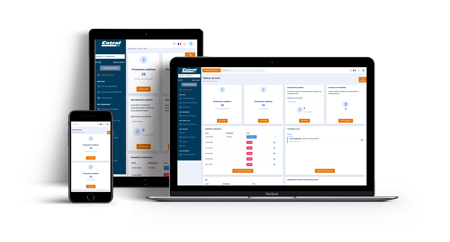Do you work in a noisy environment? Do your employees complain of being tired, of experiencing discomfort? Acoustic trauma or auditory fatigue, tinnitus and hyperacusis can sometimes be the dramatic manifestations and consequences of a noise-related accident at work.
Learn about these pathologies and how to avoid irreparable damage.

When the working environment becomes harmful to health
Outdoor activities (construction), office atmosphere (open spaces), factory and workshop machines... the list can be long when it comes to the potential noises that can impact our hearing and the good health of our ears.
When we observe a typical day for certain employees, we note that more and more people are exposed to noise and discomfort.
Indeed, prolonged and/or repeated exposure is sufficient for the ear to gradually lose its hair cells.
As for sound trauma, on the other hand, often much more damaging, it can lead to a total loss of hearing.
Beyond the risk of deafness, there are other symptoms associated with working in a noisy environment.
They are manifested as auditory fatigue and sometimes result in tinnitus and acute sensitivity to noise (hyperacusis).
What is tinnitus?
Buzzing, crackling, whistling, continuous or intermittent... Have you ever experienced this phenomenon in your ears or in your head?
These noises, produced by your body without external sound sources, are referred to as tinnitus.
The World Health Organization (WHO) estimates that 20% of the world's population is affected by tinnitus and/or hyperacusis.
There are two types of tinnitus:
- Objective tinnitus: Most tinnitus of this type can be heard by the doctor. Caused by blood problems or mechanical disorders, it is audible by others apart from the patient. It is quite rare, but if correctly identified, it can be rapidly resolved and treated. (Pulse tinnitus).
- Subjective tinnitus: In this case, which represents most tinnitus cases, only the patient hears it. Its cause remains relatively unknown and consequently it is difficult to treat. It is often proposed that tinnitus should be treated globally, focusing particularly on acceptance, so that patients learn to tolerate the presence of their internal noise.
Tinnitus is frequently associated with various symptoms such as hypertension, stress and anxiety.
Today, from 50 to 77% of respondents agree that tinnitus causes sleep disorders.
In some cases, tinnitus is accompanied by hyperacusis, but this term is not well known.
What is hyperacusis?
Hyperacusis can be defined as a heightened perception of sounds. It refers to an intolerance of noise, even quiet and ordinary sounds. In other words, a hyperacute person is hypersensitive to sounds.
This hearing impairment should not be confused with normal sensitivity to background noise. For a hyperacute person, the sounds become annoying, unbearable, even painful, depending on the degree of damage.
Hyperacusis may occur in isolation but may sometimes be accompanied by other uncomfortable symptoms such as migraines (headaches) or tinnitus.
According to current estimates, about 40% of people with tinnitus are affected by hyperacusis.
Auditory fatigue
Tiredness often felt at the end of the day or on weekends. This is generally caused by an accumulation of noise disturbances. In the professional context, it is the environment that may be considered noisy.
Auditory over-sensitivity
This is a more severe auditory fatigue. The people concerned are "negatively" sensitive, picking up on slamming doors, knocking objects, sirens, etc. This can be described as a predisposition to auditory trauma.
Hyperacusis
The auditory trauma has occurred, and the inner ear (sensory cells) is more or less affected. This is the "damage" stage.
We thus move from auditory fatigue (which becomes one of several manifestations) to auditory discomfort, from over-sensitivity to pathological auditory over-stimulation, the scale of sensations being totally disturbed, with or without hearing loss.
In the latter case, it is not that the ears hear better, it is that they struggle to play their role as a filter.
From a practical point of view, the sufferers are disturbed by noises normally tolerated by everyone: impact between objects, loud and high-pitched voices, paper crunching, etc. Main manifestations: headaches, fatigue, feeling of having a blocked ear.
Even if it is still possible to engage in the basic activities of daily life, their social life is already affected.
This hyperacusis is accompanied by tinnitus, which varies from person to person.
Painful hyperacusis
Noise and activities become almost traumatic. Hyperacusis can be described as painful because exposure to noise, regardless of its intensity (especially above 40 dB), becomes disturbing and synonymous with pain.
Travelling, working, communicating, going out: none of this is possible, causing great difficulty.
The use of earplugs, although useful and recommended, does not always succeed in containing certain disturbances and preventing a relapse.
There are also physical symptoms observed:
- Inflammation of the inner ear, sometimes radiating into the neck to the jaw
- Blocked, congested ears...
- Redness on the face with a feeling of heat, headaches, fatigue.
Painful hyperacusis is hidden and experienced as disabling, even if it is not recognised.
In times of crisis, tinnitus is much more severe and difficult to tolerate.
Hyperacusis is an aggravating factor.
Painful and severe hyperacusis
Traumatised sufferers of hyperacusis rarely leave home and they function in slow motion. The clinical manifestations mentioned above are exacerbated.
Like with tinnitus, when hyperacute patients are asked, they all tell us of a strong impact on their social lives (66%) and their family lives.
In 4th place comes professional life for 47%.
Undoubtedly, this creates collateral damage such as irritability (71%), anxiety, isolation from others and sometimes depression (28%).
One in three hyperacute patients suffer in silence and only 25% of them report having consulted a medical professional.
When they do consult a general practitioner or specialist, it appears that for half of them no provisions have been made.
Ears and Disability
Reports on tinnitus and hyperacusis
Noise and accidents at work
When we talk about noise-related accidents at work, we often think of the industrial and construction sectors, workers in factories or on construction sites handling noisy machines or jackhammers.
These sectors are obviously affected, but other sectors and/or work environments can lead to auditory fatigue or even sound trauma.
Let's take the example (among many others) of an acoustic shock.
This is a rare and unpredictable electro-acoustic event leading to intense (often short) noise levels received in headsets used by operators in telephone call centres.
Sometimes causing sound traumas recognised as accidents at work (hyperacusis, temporary delay of the hearing threshold), they are unbearable for employees and preventive measures must be put in place to improve the conditions of these employees.
How to prevent tinnitus in the workplace
Pre-emptive action through risk assessment is the starting point for a preventive approach to noise risk.
Companies can act by reducing noise at source but also by taking action on noise propagation (e.g. the partitioning and enclosure of machines).
Personal Protective Equipment (PPE) should be used when it is not possible to put all means of collective protection in place (due to various technical or financial difficulties).
There are different types of noise barriers, such as noise-cancelling headphones, shaped earplugs or moulded earplugs.
Which one to choose
You want to prioritise comfort, preserving communication and promoting concentration... so customised moulded earplugs meet the most demanding criteria on the market. They enable the protection of employees, and adaptation to their environment without isolation.
Depending on the needs of each individual, the choice of filter means intense noise can be attenuated on certain frequencies or in a linear way, making it easier to understand a conversation and adapt to all levels of noise.
Find out how to fight noise by downloading your white paper "6 essential elements against noise at work".


